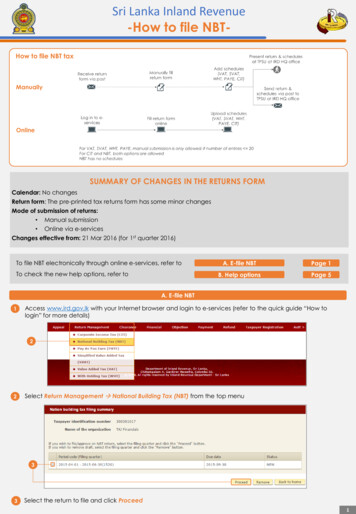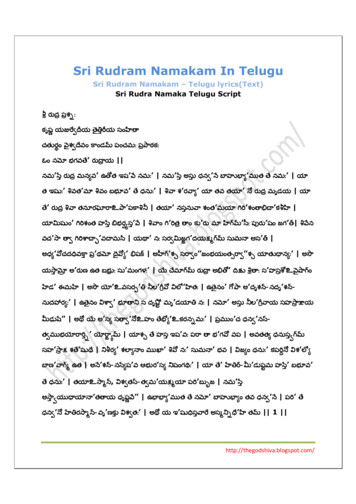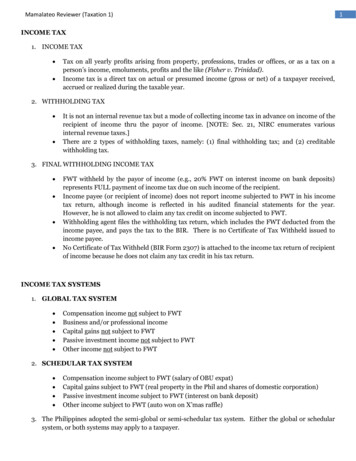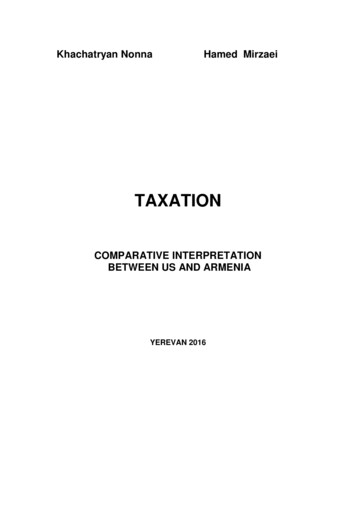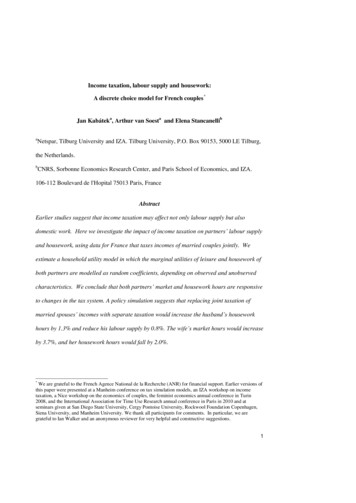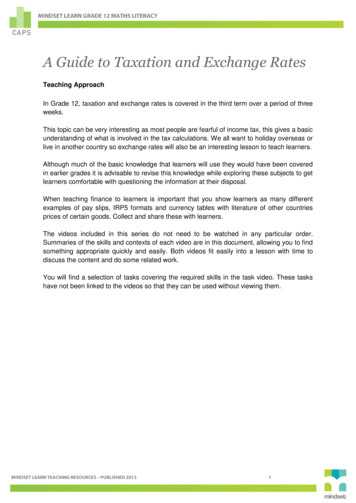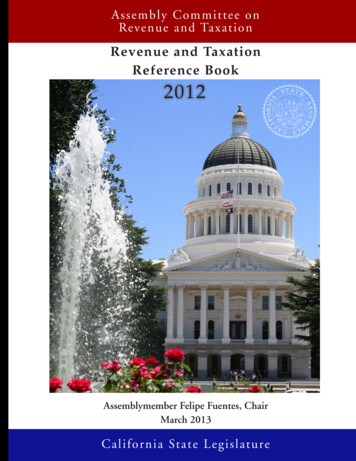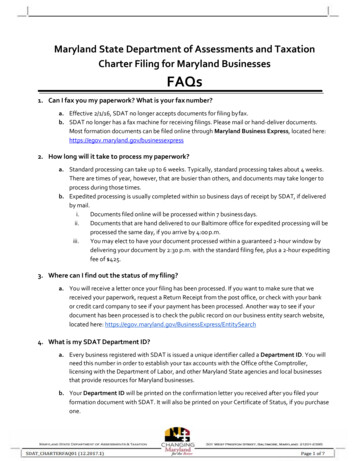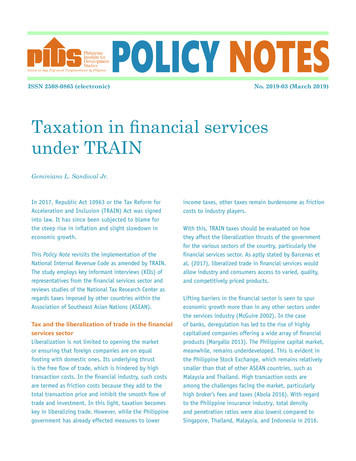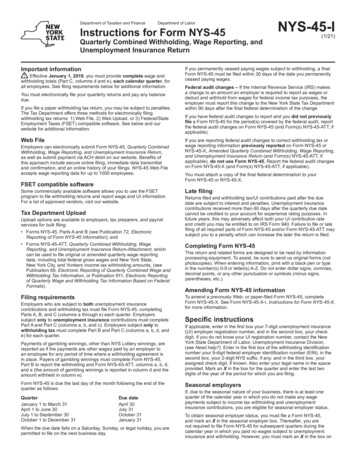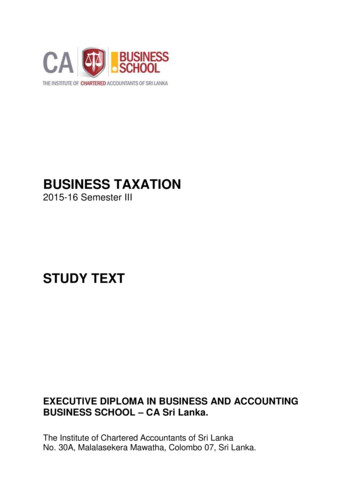
Transcription
BUSINESS TAXATION2015-16 Semester IIISTUDY TEXTEXECUTIVE DIPLOMA IN BUSINESS AND ACCOUNTINGBUSINESS SCHOOL – CA Sri Lanka.The Institute of Chartered Accountants of Sri LankaNo. 30A, Malalasekera Mawatha, Colombo 07, Sri Lanka.
Prepared byDamith GangodawilageDesha Shakthi, Lanka Puthra, Vishwa Abhimani.MBA (USQ) (Aus.), PGD (BFA), EDBA, ATII, HNDAFMAAT, ACPM, AIPFM (UK).damithlk@gmail.com 94 773 597884This text book is developed for Executive Diploma in Business and Accounting of BusinessSchool, CA Sri Lanka. No part of this text book reproduction, distribution, utilization orcommunication by any forms or any means without prior permission. 2016, Damith Gangodawilage. All rights reserved
Table of ContentsBusiness Taxation Syllabus. 4Assessment. . 5Group Assignment. 6Evaluation Criteria: . 7Study Schedule. 8Section A . 9Module 1: Principles of taxation. . 10Module 2: Profits and income chargeable with tax. . 17Module 3: Taxation of unincorporated entities. . 41Module 4: Taxation of Companies. . 60
Business Taxation Syllabus.Executive Diploma in Business & Accounting (EDBA).Academic Year 2015/16 – Semester III.1. Principles of taxation.2.3.4.5.6.7.8.9.Economic and social function of taxation. Difference between accounting profit andtaxable profit. Principles of taxation. Difference between direct tax and indirect tax. Different source of statutory provisions.Profits and income chargeable with tax.Chargeability of income tax. Sources of profits and income chargeable with incometax.Taxation of unincorporated entities.Ascertainment of profits and income of an individual. Aggregation of child’s income. Ascertainment of Statutory income of an individual. Ascertainment of Assessableincome of an individual. Ascertainment of Taxable income of an individual. Legalstatus of partnership. Ascertainment of profits and income of Partnership. Ascertainment of profits and income of clubs, charitable institutions and association.Taxation of Companies.Definitions of corporate bodies. Tax structure of a Company. Resident and Nonresident Company. Basic understanding of Thin Capitalization and Transfer Pricing. Distribution Rules. Director’s responsibilities and liabilities. Remittance tax. Computation of Tax Liability of a Company.Indirect taxes.5.1. Value Added Tax.The Scope. Imposition of VAT. Registration. Calculation of VAT payable. Introduction to SVAT & FVAT.5.2. Nation Building Tax.The Scope. Imposition of NBT. Registration. Calculation of NBT payable.Tax planning.Introduction to tax planning. Assessments on undisclosed income. Deferredtaxation. ECS.Statutory Compliances.Anti – Avoidance provisions. Statutory provisions and judicial precedents selfAssessment System. PAYE Scheme. Tax Incentives and concessions.Introduction to International taxation.Causes for double Taxation. Tax havens and Treaty Shopping. Introduction to taxtreaties (UN & OECD Model).New Trends in Taxation.E-commerce. Digital Taxation.
Assessment.Assessment of EDBA semester III consists of,-Self-assessment questionsSome modules are included self-assessment questions for you to assess thelevel of knowledge of the subject area gathered in the classroom. Thesequestions are not form part of your final assessment. If you attempt themdiligently it will help you to achieve the desired result expected from this course.-Group AssignmentsThis consist of two parts, case analysis report and presentation of the findings.Hardcopies of your assignments should be submitted to your course coordinatorat the Business School and the softcopies to be submitted to damithlk@gmail.comon or before the due date. Late submission will not be considered for marking.-ExaminationAt the end of semester there will be a written exam. Question paper consists withthree sections with maximum of five or six questions for 100 marks.Section A consists with 10 MCQs and two marks allocated for each question. Allquestions of this question is compulsory to answer.Section B consists with two or three questions to test the practical understandingof tax computation. This section questions will carry 60 marks.Section C questions cover module 6 to 9. There are one or two questions in thissections and allocated 20 marks.Details of AssessmentAssessment typeMarksWtg %Case analysis report10035Presentation10015Examination10050Pass markDue date10th June 201625%25%18th June 201609th July 2016
Group AssignmentType of the AssignmentMarksLengthCompliance Report35%2,500 words max.Presentation of findings15%8-10 slides max. for 15 minutesAssume that your team is planning to start a business in Sri Lanka. Business can becarried out in different forms. It can be a corporate entity or unincorporated entity.Depending on the business entity, types of compliance and tax liability will be varied.Compare and contrast the compliance structure of different types of business entriesexist in Sri Lanka and identify the ideal business type fit for your business with theproper reasoning.Your compliance report should cover the following areas.1.2.3.4.Executive summary.Table of contents.Introduction (state why the report has been prepared and how the report is structured).Overview of the Company (background of the business, Vision & Mission,organizational structure, Key business operations etc.).5. Different business types exist in Sri Lanka.6. Compliance dashboard of each business type.7. Compare and contrast the compliance structure of different types of business.8. Business type fit for your business and reason for selection.9. Evaluate the compliances to be adhered by your business.10. Conclusion.11. List of references.12. Appendices.General Information:--The report should have a cover page to include a meaningful title, Name of yourgroup, date, course name and Semester, Subject and the lecture, Word count etc.Evaluation Criteria should be included in the second page.Group members detail should be provided in the third page.Harvard referencing system should follow to cite your source. A full list ofreferences in alphabetical order must be included.You may include any additional supporting information in the appendices.Information in the appendices should only be included if it is relevant and referredin the report.Report should be used Times New Roman 12 point font with double line spacing.
Evaluation Criteria:Maximum MarksMarksObtainedPenaltiesUnderstand the Firm and its operations.Students should provide enough information to enable the reader to understandwhat the business is and its operations.Compare and contrast the compliance structure of differentbusiness types.The level of understating of different business types and compliances they need toadhere.Identify and evaluate the compliance structure of the selectedbusinessFind out the suitable business types and applicable compliance and regulatoryrequirements and understanding of compliance dashboard.Structure of the Report and ReferencingYour list of references should adhere to the Harvard referencing style. Use ofcurrent materials and facts related to the business, Clear headings andsubheadings, Correct labelling of tables, diagrams and appendices.Organising PowerPoint presentationThe content of the presentation should be organised in a logical mannerand interesting sequence, that is easy to follow.PowerPoint slide design and layoutEach slide should present one central idea with supporting facts, and isvisually pleasing and not overloaded.DeliveryPresenter should convey a clear, cogent and coherent argument tosupport your evaluation and findings.Conclusion and recommendationsThe conclusion should summarise the key points of your presentation.The recommendations should highlight the findings and leanings yougathered.Total (I) Presentation of findingsCompliance ReportMarking Criteria812105335450 Evidence of plagiarism or collusion Spelling and grammatical errors Late submissionTotal (II) (Max. – 50)Final Marks (I) – (II) OVERALL COMMENTS:
SessionStudy Schedule12DateModuleActivity12.03.2016Module 1: Principles oftaxation.Lecture19.03.2016Module 2: Profits andincome chargeable withtax.LectureModule 2: Profits andincome chargeable withtax.Module 2: Profits andincome chargeable withtax.Module 3: Taxation ofunincorporated entities.Module 3: Taxation ofunincorporated entitiesModule 4: Taxation ofCompanies.Module 4: Taxation ofCompanies.Module 5: Indirect taxes.Module 6: Tax 4.06.2016Module 7: StatutoryCompliances.Lecture-10.06.2016Group AssignmentReportAssignment1211.06.2016Module 8: Introduction toInternational taxation.Lecture1318.06.2016Module 9: New Trends in Lecture/Taxation.Presentation-09.07.2016Semester end writtentest – Business TaxationReadingAssignmentSocial implicationand functions of taxin market economyconditions. GlukhovV.V., Rozhkov Y.V,2014Some preliminaryobservations on thelaw of income tax inSri Lanka. M.S.M.Samaratunga, SriLanka TAX RAVIEWVol. 14 No. eLectureExamIRD Circular no.SEC/2014/05 & 06Report Writing.Comm. Skill HandBook, 3eAssignmentis due forsubmissionGrouppresentation9.00am – 12.00pm
Section AModule 1 - 4
Module 1: Principles of taxation.Outline: Economic and Social Functions of Taxation. Difference between Accounting Profit and Taxable Profit. Principles of Taxation. Basis of recognition of profits and income Residential status Difference between direct and indirect tax.1.1 IntroductionTax is central to all business decisions. Ever-increase body of legislation, precedent andpractices demand professionals to have technically correct and commercially soundknowledge in taxation.1.2 What is Tax?There is no universally agreed definition for tax. Tax is a price paid by the citizen fortheir wellbeing and civilization. It is a compulsory charge imposed by the government.Tax may not have direct benefit but indirectly it is benefited to the public at large.1.3 Economic and Social Functions of Taxation.Government is facing the following fiscal pressure in the 21st Century. The mainobjective of collection of taxes to spend for various economic and social activities andinfrastructure development of the country. Ageing populationPressure to support for education and social welfarePressure for InfrastructurePressure to reduce taxesTransition from manufacturing based economy to services based economy1.4 Functions of Taxation.Tax is a personal obligation of the people. People should tax according to their ability topay. Therefore, tax policies are framed based on certain principles. They are equity,certainty, simplicity, progressivity, convenience and stability.
1.5 Sources of Statutory Provisions.To understand Income Tax, we need to have an understanding of the sources of tax lawin the Country.PrimarySourcesSecondarySourcesPrimary Sources of tax law Statutory Sources Inland Revenue Act Administrative Sources Revenue Ruling Gazette Notifications Interpretation of provisions Judicial SourceSecondary SourcesSecondary sources are not themselves the law but provide commentary on a particularsubject.
GuidelinesCommentariesText books /HandbooksLegal dictionaries1.6 Difference between Accounting Profit and Taxable Profit.Accounting Profit is the amountreported in accordance with accountingstandards.Taxable Profit is the Net Profits & Incomederived from any sources for any year ofassessment.1.6.1 Define the Profits & Income.IRD Act does not defined what is profit and income. It is merely described the sourcesof profits and income and prescribed the methods of computing income.Income and capital is not necessarily conclusive. What is paid out of the profits may notalways be income. One has to look at all the relevant circumstances and reach aconclusion according to the general tenor and combined effect.[Lord Mac Dermot, Harry Ferguson Motors Ltd Vs. CIR (33 TC 15)]The name given to transaction does not necessarily decide the nature of thetransaction. The question always what is the real character of the payment and not whatthe parties call it.[I.R Vs. Wesleyan General Assurance Society (30 TC 11)]The words Profit and Income are clearly not synonymous. They are not to be used interchangeably or indiscriminately.[Soertuz J, Ceylon Financial Investments Ltd Vs. CIT (1 CTC 206, pg 252)]Anything in the nature of capital accretion in excluded as being outside the scope andmeaning of the act.[Rowlatt J, Ryall Vs. Hoare (8 TC 521)]
1.6.2 Income & Capital Receipt.1.7 Basis of recognition of Profits and Income.[S2(1)/2006-10]1.7.1 Component of Profits & Income: Profits from Trade, Business, Profession or vocation.Profits from employment.Net Annual Value (NAV).Occupier’s Income.Dividends, Interest or discounts.Charges or Annuity.Rents, Royalties or Premium.Winning from a Lottery, Betting or Gambling.Money received by a NGO.Profits from any other sources[S3/2006-10]
1.7.2 Measurement of Profits & IncomeProfits or Income means the net profit or income from any source for any periodcalculated in accordance with the provisions of the Inland Revenue Act.[S217/2006-10]1.8 Residential Status.Tax is levied on person. Person includes a Company or body of persons or anygovernment.Person-An IndividualA CompanyA TrustAn Executor or AdministratorA Co-0pearative SocietyAn Association, Club or Society of Persons whether corporateor unincorporatedA Charitable InstitutionA Hindu undivided familyAny Local or public AuthorityA Government[S217/2006-10]1.8.1 Residential Status of Individual.Residential status important in taxing individuals in Sri Lanka.[S79 (2)-(6)/2006-10]1.8.2 Residential Status of a Company or Body of Persons.Company means, any Company incorporated or registered under any law in force in SriLanka or elsewhere and includes public corporation.Public Corporation means, any corporation, board or other body which was or is,established by or under, any written law, other than the companies Act, No 7 of 2007,with capital wholly or partly provided by the Government, by way of grant, loan or otherform.[S217/2006-10]
[S79 (1)/2006-10]1.8.3 Year of Assessment (YA).Income tax is charged on a current year basis. A Year of Assessment is the 12 monthsperiod commencing from Residential 1st April to 31st March in the following year.All accounts of trade, business, profession or vocation are to be made up for the periodspecified above.[S28 (2)/2006-10]CGIR may allow taxpayer to deviate from the general rule but not legally empowered torevoke such decision.[S28 (3)/2006-10]1.9 Direct Tax & Indirect TaxDirect Tax is a tax that is paid directly by an individual or organization on whom it isimposed. Direct tax cannot be shifted to another individual or entity. The individual ororganization upon which the tax is levied is responsible for the fulfilment of the taxpayment. Indirect taxes, on the other hand, can be shifted from one taxpayer to anotherbut direct tax cannot be passed on to others. In Sri Lanka Income Tax is the main DirectTax.Indirect Tax is the tax that increases the price of a good so that consumers are actuallypaying the tax along with the price of the goods. Indirect tax is most often not born bythe person on whom is levied. It is shifted from one taxpayer to another, by way of anincrease in the price of the good. VAT, NBT are the indirect tax in Sri Lanka.
1.10 Practice Questions1.1Mr. Sunimal’s movements during the YA 2013/14 & 2014/15 are as follows,ArrivalDeparture01.05.201325.06.201356 days18.08.201320.11.201395 days22.12.201313.01.201423 days24.03.201405.05.201443 days31.07.201428.12.2014151 days15.10.2015Period of stay in SL-You are required to assess the residence status of Mr. Sunimal for the YA2013/2014 & 2014/2015.1.2Date of arrivals and departure of Ramalin are as 2016-You are required to assess the residence status of Ramalin.1.3Where a company has its registered office in Sri Lanka or principle office in Sri Lankaand the control and management of its business are exercised outside Sri Lankadeemed to be a resident company in Sri Lanka.1). The above statement is correct.2). The above statement is incorrect.3). No relevance to tax law.4). Described the non-resident company.
Module 2: Profits and income chargeable with tax.Outline: Basis for Chargeability of Income TaxTypes of profits and IncomeSources of Profits and Income.Measurement of Profits and Income2.1 Basis for Chargeability of Income TaxUnless a person brought within the charge imposed by Section 2 cannot be taxed.The profits and income of any person has been arisen or derived for any year ofassessment is chargeable with tax is the subject matter for Income Tax.The Income Tax Act impose a territorial limit; either(1). That from which the taxable income is derived must be situated in the UnitedKingdom, or(2). The person whose income is to be taxed must be resident there.[Lord Herschell in Coloquhoun Vs. Brooks (2 TC 490)]2.1.1 Incident of Income TaxIncome tax shall, subject to the provisions of this Act, be charged at the appropriaterates , for every year of assessment . in respect of the profits and income ofevery person (a) wherever arising, in the case of a person who is resident in Sri Lanka ; and(b) arising in or derived from Sri Lanka, in the case of every other person.[S2/2006-10]2.1.2 Arising in or Deriving from Sri Lanka.The word arise means, to spring up, originate, to come into being or notice, to comeoperative .Therefore profits and income must accrue for the benefit of a person to charge.The word derive means, to receive from a specific source, proceeds from property .[Black’s Law Dictionary, 6th Edition]
2.1.3 Place where the profits and income arising in or deriving from.The word derived implies that the source of the profits or income must be fromCeylon In my opinion these two wards “arise” and “derive” were meant to includethe case of the Ceylon Company when it makes any profits or gets any income foranything done in Ceylon [Akbar J. in Anglo Persian Oil Co. Ltd Vs. CIT (1 CTC 82)]If he has rendered a service or engaged in an activity such as the manufacturing ofgoods, that profits will have arisen or derived from the place where the service wasrendered or the profits making activity carried. But the profit was earned by theexploitation of property assets by letting property, lending of money or dealing incommodities or securities by buying and reselling at a profit, the profits will have arisenin or derived from the place where the property was let, the money was lent or thecontract of purchase and sale was effected.[Lord Bridge in Hang Seng bank Ltd (1 AC 306, 1991)]2.2 Types of profits and IncomeProfits and income arising or derived from Sri Lanka is include,a). Services rendered in Sri Lankab). Property in Sri Lankac). Business Transacted in Sri Lanka[S2/2006-10]a). Services rendered in Sri LankaProfits and Income arise at the place where the services are rendered and not theplace where the contact of, or for services is concluded. The rendered implies thatthe place where the actually perform the services.Eg: employment, professions, vacation, carried on in Sri Lankab). Property in Sri LankaProperty defined to include any interest in any movable or immovable property(S163/206-10).Eg: rent from house, dividends, interest. . the two ships . belongs to the appellant were not passing through Sri Lankabut were in Sri Lanka water from 1985 to September 1986. . take the viewthat . clearly established that the appellant’s ship constitute property in SriLanka .[Somawansa J in Trust Union Shipping Corporation Vs. CGIR (3 SLR 43, 2003)]
c). Business Transacted in Sri LankaBusiness is defined in the act to include, an agricultural undertaking, the racing ofhorses, the letting or leasing of any premises including any land by a company orforestry.The trade is defined to include, every trade and manufacture and every adventureand concern in the nature of trade.Eg: agriculture, industrial or other business carried on in Sri Lanka.2.2.1 Determine the place where the business transacted2.3 Profits and Income.Profits and income of any person in respect of the tax is chargeable is the net profit andincome from every source calculated in accordance with the provisions of the Act[S217-10/2006]. In the other hand the profits and income calculated in accordance withthe provision of the Act is constituted as the statutory income.2.3.1 Sources of Profits and Income.Section 3 of the Inland Revenue Act No. 6 of 2006 enumerated the sources of profitsand income chargeable with tax.1). Profits from any trade, business, profession or vocation2). Profits from any employment3). Profits from immovable property4). Income from interest5). Income from dividends6). Charges or Annuities7). Royalties8). Profits from Lottery, Betting or Gambling9). Sums Received by NGO10). Income any source other than casual and non-recurring nature.
2.3.2 Measurement of Profits and IncomeProfits or income means net profit or income from any source for any period calculatedin accordance with the provisions of the Act.There shall be deduction for the purpose of ascertaining the profits or income of anyperson from any source, all outgoings and expenses incurred by such person in theproduction thereof .Profits and Income outside the scope Capital ReceiptsGiftDonationProfits of casual and non-recurring nature2.3.3 Memorandum for Computation.Profits and Income:Statutory income from employmentStatutory income from dividendStatutory income from interestStatutory income from trade etc .Total statutory incomeLess: Permitted deductionsAnnuityGround rent & RoyaltyInterestLossesAssessable incomeLess: Tax Free AllowanceQualify paymentTaxable (XXXX)XXXX(XXXX)XXXXX2.3.4 Total statutory income.The statutory income is the income of every taxable source arose, derived or accrued toany person during a year of assessment. However, income tax liability is computed onthe taxable income of a person.Total statutory income is the aggregated amount of the statutory income from everytaxable source.
Profits and Income:Statutory income from employmentStatutory income from dividendStatutory income from interestStatutory income from trade etc .Total statutory incomeXXXXXXXXXXXXXXXXXXXX2.3.5 Assessable income.Assessable income it the residue of the total statutory income after deducting aggregateamount of the deduction specified in S32.Annuity:Not defined in the act. It is fixed sum received annually under a legal obligation as arecurring or capable of recurring but not in capital nature.Ground rent:It is known as a rent charged. The regular payment made by the owner of a leaseholdproperty to the freeholder under a lease agreement.RoyaltyPayment made by one party to another for the right to use of an asset. Such as patent,copyright, trade mark, industrial design, license for the manufacturing process.InterestInterest paid on a loan obtained for the construction or purchase of any building orpurchase of a land to construct a building, to utilize in trade business profession orvocation and paid under legal or contractual obligation to any licensed bank or anyregistered finance company.Other person recognized by the CGIR (i.e a person who declared such interest asincome)2.3.6 Losses:Loss arise from the statutory source Deemed loss Loss arise from the statutory sourceLoss is the loss ascertain as per the manner provided in the Act for the ascertainment ofthe profits and income. There may be, Loss incurred during the YALoss B/F from previous yearDeemed lossThe excess of the any sum paid by way of annuity, ground rent, royalty or interest overthe total statutory income is treated as loss incurred in a trade.
However, the deduction of loss is limited to 35% of the total statutory income [S32 (5)(b)].2.3.7 Taxable income.Taxable income is the residue of the assessable income after deducting the aggregateamount of tax free allowance and qualifying payment.Taxable income of resident individual and charitable institution shall be the residue afterdeducting the aggregate amount of tax free allowance and qualifying payment.However, taxable income of every other person shall be the assessable income afterdeduction of qualifying payment [S33 (2)].2.3.8 Qualify payment:The certain payment and expenses allow to deduct from assessable income toencourage the people [S34(2)].- Donation to approved charity- Life Insurance premium paid annually 3 year- Medical Insurance premium paid for otherthan incurable disease1/3 of SI or 75,000Whichever is lowerno limit andbalance can be C/F- Donation to government funds- Insurance premium paid for incurable diseases- Expenditure on government plan - limit to 25000 and balance can be C/F- Expenditure on film production, construction and equipping of a cinema and upgradation of cinema.- Expenditure on community development project# In economically marginalize village- Limited to 1,000,000# Investment not less than 50Mn in FA in the- Max 25% per yearexpansion of certain undertaking- The profit of the employment income in excess of 500,000/- or 100,000/- whicheveris lower.- Repayment of housing loan obtained by professional - not exceed 600,000/Once the taxable income calculated, the relevant tax rate to be applied in computing thegross tax liability of a person. Normal rate (4 – 24 percent progressive rate)Reduced rateHigher rateGross tax payable taxable income X tax rateLess: Tax credits XXXX(XXX)Balance tax payableXXXX
Tax Credits:-PAYE TaxWHT on royalty, annuity or management feesTax deducted on dividendsSelf-assessment paymentESCDouble tax relief2.4 Profits from Immovable Property.Income arising from the ownership of land & improvements thereon are the subjectmatter for charge the tax on the owner. [S.5,6].1). Net Annual Value (NAV)2). Rent Income3). Occupier’s Income2.4.1 Net Annual Value (NAV):The Net Annual Value of lands and improvements thereon occupied by the owner or onbehalf of the owner for the purpose other than trade, business . Is chargeable withincome tax. [S3(c)].The NAV is a hypothetical or a notional income from property chargeable with incometax. Which is not an income received in monitory terms.When the owner occupies or someone else occupies on behalf of the owner, NAV istreated as income to the owner.However, any premises use by the owner for trade, business, profession or vocation isnot chargeable with tax as a source.2.4.2 Determination of NAV:NAV is determined by deducting 25% of the Annual Value - i.e. the value assesse bythe local authority for payment of rates- for repair and other expenses. [ S5(2) &S26(3)].Annual Value / Rating AssessmentLess: 25% Allowance for RepairsNAVXXX(XX)XXXIn case of unrated area, the NAV is determined on the basis of rate which a tenantmight reasonably be expected to pay. Generally, Revenue determine NAV of suchproperty at 5% of its capital value.
2.4.3 Rent Income: [S3(g)]Where the property is let, the NAV will not be assessed as income to the owner as theproperty is not occupied or deemed occupied by the owner. The only source of suchproperty would be the rent income.However, any income received for using any premise for trade, business, profession orvocation is not the income under source of rent (S217).Determination of Rent income: [S6]Gross RentLess: Rates borne by the OwnerLess: 25% Allowance for RepairsNet Rent IncomeXXX(XX)XXX(XX)XXXWhere the net rent is less that the NAV, then NAV is considered as the income fromrent for payment of tax. However, NAV should not be higher than the gross rentreceivable. If the NAV is higher than gross rent, then income liable for tax is limited tothe gross rent.2.3.4 Furnished House:Where the owner resides furnished house or bungalow permanently, even it is vacant,is considered as occupied by him. In such situation income from these houses would bethe NAV.However, such house is rented out then there will be income from,Unfurnished rent (NAV).Profit from furnished.Unfurnished rent (NAV).Rental Value (Rating Assessment)Less: Rates PaidLess: 25% allowance for RepairUnfurnished Rent / NAVProfit from Furnished.Rent ReceivedAdd: Rental value of the period occupied/deemed to be occupied by the ownerXXXX(XXX)XXXX(XXX)XXXXXXXXXXXXXXXLess: Furniture up keeping, Agent’s commission,2.4.5 Exemption from NAV & Rent:Advertising & Cost of inventory(XXX)Rental Value for the year(XXX) (XXX)Profit from furnishingXXXXIncome from Rent-
NAV/rent income is exempted from tax in respect of the house is used
Depending on the business entity, types of compliance and tax liability will be varied. Compare and contrast the compliance structure of different types of business entries exist in Sri Lanka and identify the ideal business type fit for your business with the proper reasoning. Yo

